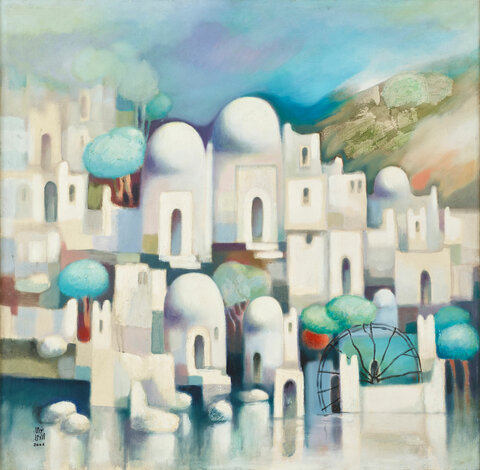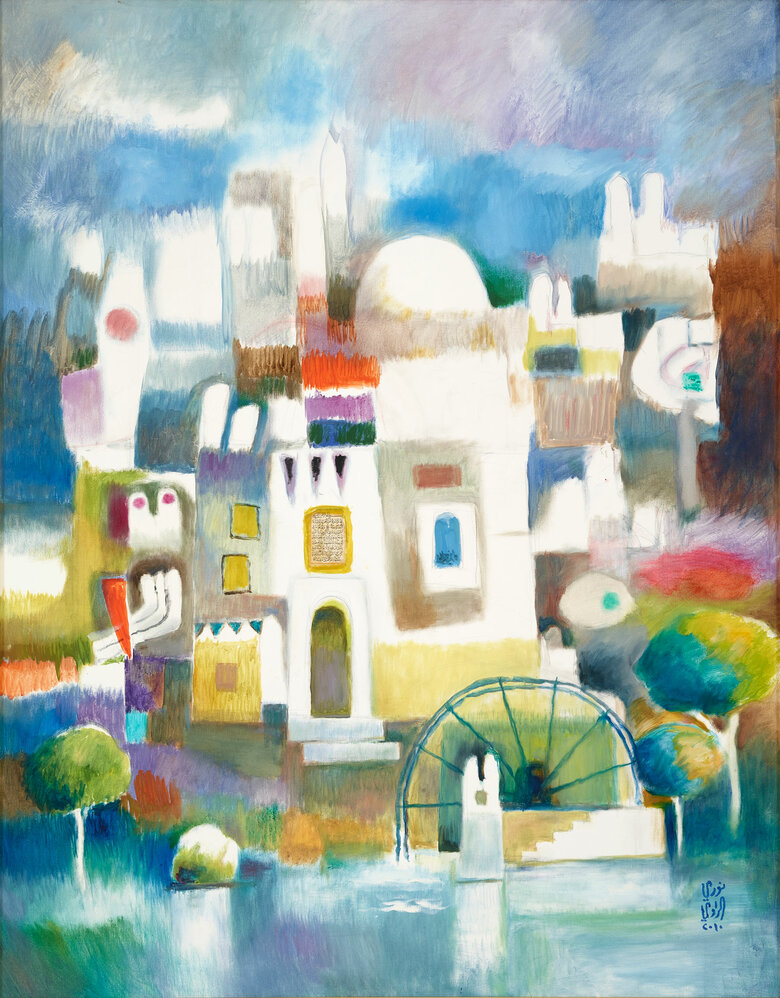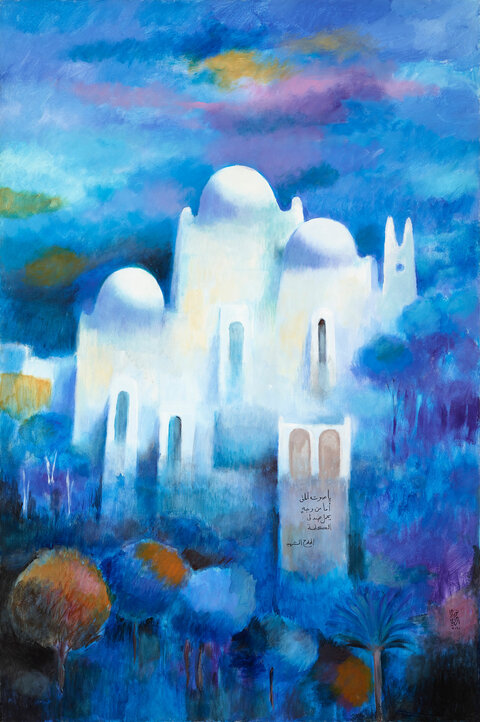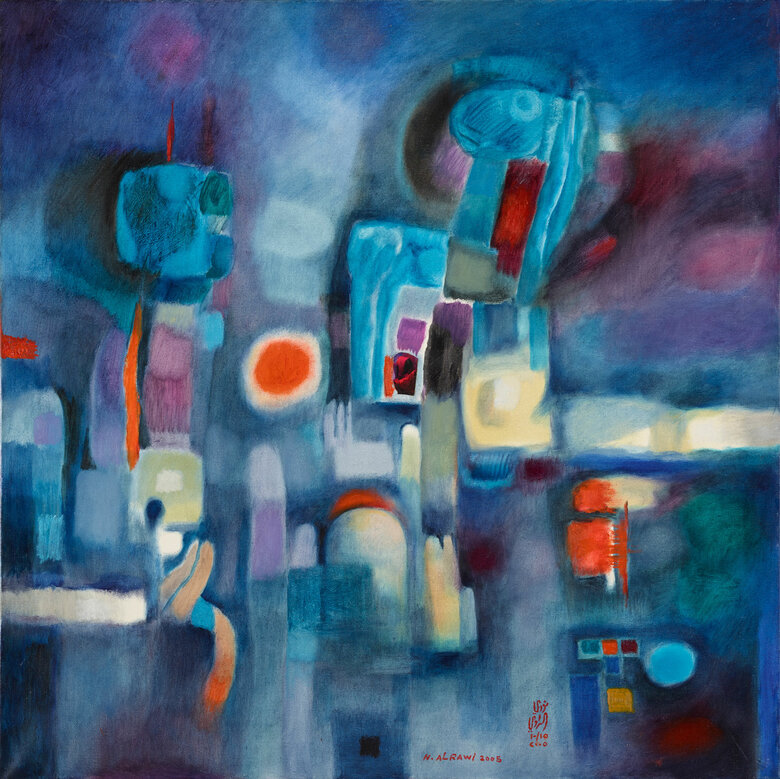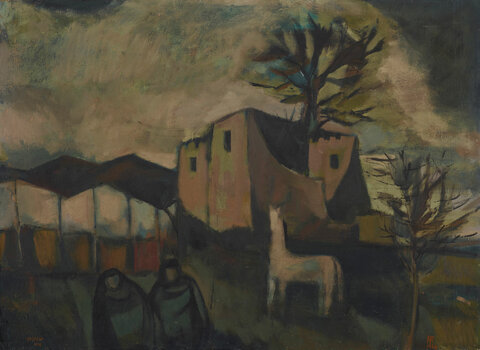Untitled, 2006, an abstract figurative painting by Iraqi artist Nouri Al Rawi, depicts a city nestled along the river's edge, surrounded by sloping hills and interspersed with trees amidst the various buildings. The city is made up of a series of houses and mosques, many of which have distinct white domes 1 and traditional architecture with arched doorways and windows. The interplay of varying dome levels and sizes in the middle register accentuates the architectural intricacy and depth of the city. The subtle touches of ultramarine blue, cadmium red, and viridian breathe life into the painting as they contrast sharply with the predominant whites and the softly blurred geometric shapes throughout the landscape. Furthermore, the organic trees and the distinctive water wheel on the right register helps disrupt the city's architectural repetition, while the cobalt blue with light strokes of purple in the upper register encase the city in a soft haze. The blend of these hues meld into a pastel-like palette that lends an enchanting and ethereal essence to the artwork to give it a dreamlike quality.
Through his work, the Al Rawi skillfully combines representation with imagination by drawing on personal childhood experience and memories 2 to nostalgically depict his hometown.
In the midst of the Iraqi civil war, Al Rawi's work became a testament to the enduring spirit of his hometown, Rawah 3 . The recurrent domes represent the city's architectural familiarity, linking it to its cultural legacy and historical customs. By employing the intentional repetition of a single traditional architectural design, resembling that of a mosque dome, Al Rawi conveys the idea of continuity within the village. Simultaneously, the pristine white buildings portray a city that has not been stained by chaos or discord. It conveys the idea of an enduring legacy within the village, a testament to its resilience through challenges, while also establishing a captivating rhythm that accentuates the nostalgic overtones that Al Rawi is bringing forward.
The idyllic and ethereal quality that Al Rawi allots his homeland, depicted through blurred shapes and soft textures, gives the impression that we are looking at memory through a dream. Significantly, the lack of human-like figures 4 in the village further suggests a form of childhood recollection, aligning with the notion that places are often more memorable than faces. Through intentional repetition and simplicity, the artwork conveys the very essence of childhood.
Notes:
1 The قبة (Qibba)/dome is a recurring motif in Al Rawi’s paintings.
2 Zainab Saad Ezzeddine and Mohammed Globe Jabr, “Representations of the Place in the Drawings of Nuri Al-Rawi: زينب سعد عزالدين-محمد جلوب جبر,” Al-Academy, accessed August 10, 2023,
https://jcofarts.uobaghdad.edu
3 “Nouri Al Rawi - Artists,” Dalloul Art Foundation, accessed August 10, 2023, https://dafbeirut.org/en/nouri-al-
rawi.
4 Zainab Saad Ezzeddine and Mohammed Globe Jabr, “Representations of the Place in the Drawings of Nuri Al-Rawi: زينب سعد عزالدين-محمد جلوب جبر,” Al-Academy, accessed August 10, 2023,
https://jcofarts.uobaghdad.edu reminiscence, where memories preserve outlines over intricate details. For instance, in this painting, the uniform entryways and shapes of the domes create a consistent motif that produces a feeling of familiarity and playfulness, akin to how a child's memory preserves cherished impressions of home.
Al Rawi, a pivotal figure in Iraq's modern art movement, co-founded the Baghdad Modern Art Group 5, whose goal was to promote a distinct Iraqi identity. Al Rawi's projects aimed to promote modern Iraqi art, as well as contribute to the debate over post-independence identity and cultural authenticity. His contributions strongly resonate with the preservation of cultural identity, and serve as a cornerstone in the development of Iraq’s art history. Al Rawi painted several renditions of his beloved city, Rawah, as a means to preserve its cultural identity. These versions, which represent different stages of his creative development 6 , highlight his lasting significance. They not only record the progress of the city, but they also capture the core of his own artistic journey and creativity.
5 Loulwah Kutbi et al., “The Baghdad Modern Art Group,” Mathqaf, July 30, 2021,
http://mathqaf.com
6 الفنان التشكيلي نوري الراوي | المرسال, accessed August 10, 2023, https://www.almrsal.com
signed in Arabic and dated in English front lower right


